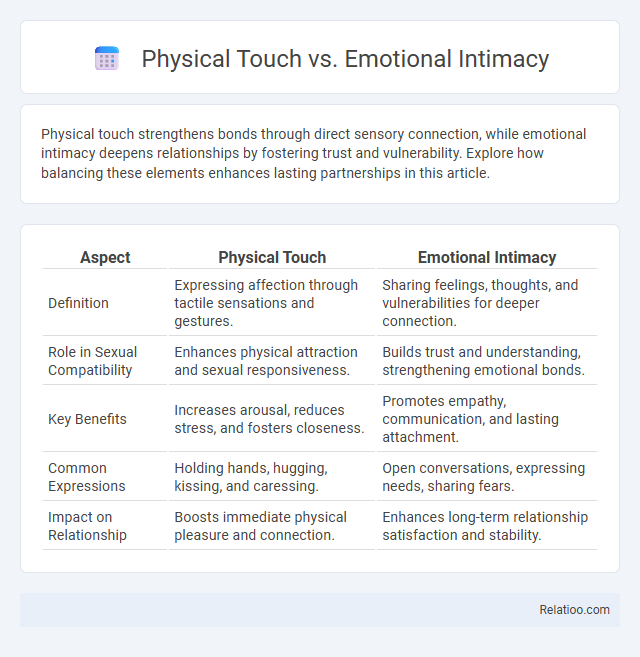Physical touch strengthens bonds through direct sensory connection, while emotional intimacy deepens relationships by fostering trust and vulnerability. Explore how balancing these elements enhances lasting partnerships in this article.
Table of Comparison
| Aspect | Physical Touch | Emotional Intimacy |
|---|---|---|
| Definition | Expressing affection through tactile sensations and gestures. | Sharing feelings, thoughts, and vulnerabilities for deeper connection. |
| Role in Sexual Compatibility | Enhances physical attraction and sexual responsiveness. | Builds trust and understanding, strengthening emotional bonds. |
| Key Benefits | Increases arousal, reduces stress, and fosters closeness. | Promotes empathy, communication, and lasting attachment. |
| Common Expressions | Holding hands, hugging, kissing, and caressing. | Open conversations, expressing needs, sharing fears. |
| Impact on Relationship | Boosts immediate physical pleasure and connection. | Enhances long-term relationship satisfaction and stability. |
Understanding Physical Touch in Relationships
Physical touch in relationships serves as a fundamental way to convey love, trust, and comfort, activating the brain's release of oxytocin, which strengthens emotional bonds. Unlike emotional intimacy that relies on sharing feelings or sensuality centered on physical desire, physical touch directly impacts the nervous system, reducing stress and fostering a sense of safety. Recognizing each partner's unique touch preferences and boundaries is crucial for maintaining a healthy connection and deepening relational satisfaction.
Defining Emotional Intimacy
Emotional intimacy is the deep sense of connection where you feel safe to share your true thoughts and feelings without judgment, fostering trust and vulnerability. Unlike physical touch, which involves tangible interactions, emotional intimacy centers on the psychological and emotional bonds that create a meaningful relationship foundation. Sensuality complements emotional intimacy by enhancing awareness and appreciation of physical sensations, but without emotional closeness, it lacks the depth required for lasting intimacy.
The Role of Physical Touch in Bonding
Physical touch plays a crucial role in bonding by releasing oxytocin, a hormone that promotes trust and emotional connection between partners. Your body's response to gentle touch enhances feelings of safety and comfort, strengthening both physical and emotional intimacy. Sensuality, while often linked to physical touch, deepens the experience by engaging the senses and fostering a more profound connection beyond mere contact.
Emotional Intimacy: Building Deeper Connections
Emotional intimacy is a crucial foundation for building deeper connections, fostering trust and vulnerability between partners. You can strengthen your relationship by prioritizing open communication, active listening, and empathy to create a safe space where both individuals feel valued and understood. Physical touch and sensuality enhance emotional intimacy but cannot replace the meaningful bond created through shared emotions and authentic connection.
Physical Touch vs Emotional Intimacy: Key Differences
Physical touch involves tangible actions like hugging, holding hands, or casual contact, directly stimulating sensory receptors and creating immediate feelings of comfort or warmth. Emotional intimacy, in contrast, centers on deeper psychological connection, built through trust, vulnerability, and open communication that fosters understanding and emotional security. Your relationships grow stronger when balancing physical touch's instant reassurance with emotional intimacy's lasting bond.
The Interplay Between Touch and Emotional Closeness
Physical touch serves as a powerful conduit for emotional intimacy, enhancing feelings of trust, security, and connection between partners. Emotional closeness deepens the meaning behind physical contact, transforming simple gestures into expressions of empathy and understanding. Sensuality bridges these aspects by engaging the senses, creating a rich, multisensory experience that amplifies both emotional and physical bonds.
Cultural and Personal Perspectives on Intimacy
Cultural and personal perspectives shape how physical touch, emotional intimacy, and sensuality are experienced and expressed, with some cultures valuing physical closeness as a primary form of connection while others prioritize emotional bonds or sensual experiences. Your understanding of intimacy is influenced by societal norms, familial teachings, and individual comfort levels, which dictate the acceptable boundaries and expressions of affection. Recognizing these diverse perspectives enhances empathy and communication in relationships across different cultural backgrounds.
Signs of Healthy Physical and Emotional Bonding
Healthy physical touch includes consistent, consensual gestures like hand-holding, hugging, and gentle caresses that foster trust and security between partners. Emotional intimacy is marked by open communication, vulnerability, and empathetic listening, creating a deep sense of connection and understanding. Sensuality involves mindful awareness of the senses and presence, enhancing mutual pleasure and reinforcing the emotional and physical bond.
Challenges in Balancing Physical and Emotional Needs
Balancing physical touch, emotional intimacy, and sensuality presents challenges as each fulfills different needs in a relationship, requiring nuanced understanding and communication. Physical touch provides comfort and connection, but without emotional intimacy, it can feel superficial, while emotional intimacy demands vulnerability that may not always translate into sensual desire. Your ability to navigate these complexities influences relationship satisfaction and emotional well-being, making it essential to address both physical and emotional needs thoughtfully and openly.
Strengthening Both: Tips for Deeper Relationship Intimacy
Physical touch, emotional intimacy, and sensuality each play distinct roles in strengthening your relationship, offering unique pathways to deeper connection and trust. Prioritize consistent quality time, active listening, and genuine expression of feelings to nurture emotional intimacy while incorporating affectionate touch and mindful sensual experiences. You can enhance relational strength by balancing these elements, fostering mutual understanding and lasting closeness.

Infographic: Physical Touch vs Emotional Intimacy
 relatioo.com
relatioo.com